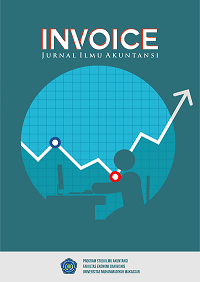SISTEM AKUNTANSI KLAIM HABIS KONTRAK PADA ASURANSI JIWA BERSAMA BUMIPUTERA 1912 CABANG UJUNG TANAH MAKASSAR
DOI:
https://doi.org/10.26618/inv.v2i1.3190Abstract
The purpose of this research was to know how accounting system for contract expired claims at AJB Bumiputera 1912 Branch Office of Ujung Tanah Makassar, contraints in the system of accounting for contract expired claims and efforts made to overcome the obstacles faced. The type and design in this study used a descritive qualitative type, namely knowing, explaining and describing the accounting system for contract expired claims in AJB Bumiputera 1912 Branch Office of Ujung Tanah Makassar. The program payment of claims through centralization. Finance Department pays immediately to the bank account of the policy holder or recipient of insurance benefit. Recording system payment of contract expiration claim using a computerized system The result showed that accounting system of contract expired claims already has accounting records accordance to their needs. It can be seen that the fractions has worked according to their duties. While the problems that are experienced in the accounting system for contract expired claims, are: lack of supervision on customer premium payments, where there are some customers who are negligent in carrying out their obligations in paying insurance premiums which result in the payment of contract expired claims not due. For this reason, it is necessary to review the system used so that the documents used are in accordance with the needs, and there is no abuse, fraud and the results can be more effective. The efforts to overcome the obstacles in the accounting system for contract expired claims are that the KUAK section (Head of Administrative and Finance Unit) conducts a routine check of premium payment receipts to avoid paying out-of-contract expired claims and sending an official notification letter from the company to the customer that the contract period will expire.
References
Harti Dwi. (2017). Akuntansi Dasar. Jakarta: Erlangga
Mulhadi. (2017). Dasar-dasar Hukum Asuransi. Depok: PT Raja Grafindo.
Mulyadi. (2016). Sistem Akuntansi (4 ed.). Jakarta: Salemba Empat.
Puspitawati, Lilis dan Anggraini Dewi Sri. (2014). Sistem Informasi Akuntansi. Yogyakarta: Graha Ilmu.
Sujarweni. V. W. (2015). Sistem Akuntansi. Yogyakarta: Pustaka Baru Press.
Undang-undang pasal 1 Nomor 2 Tahun 1992 tentang Usaha Perasuransian
Undang-undang pasal 19 Nomor 73 Tahun 1992 tentang Hukum Dagang Perjanjian Asuransi
Undang-undang pasal 1 butir (29) Nomor 40 Tahun 2014 tentang Usaha Perasuransian
Undang-undang pasal 255 tentang Hukum Dagang
American Accounting Association (AAA). (2016). “pengertian akuntansi secara umum, tujuan, fungsi, dan manfaatnya” https://www.maxmanroe.com/vid/financial/akuntansi/pengertian-akuntansi (diakses 02 Mei 2019).
American Insitute of Certified Public Accounting (AICPA). (2016). “pengertian akuntansi secara umum tujuan, fungsi, dan manfaatnya” https://www.maxmanroe.com/vid/financial/akuntansi/pengertian-akuntansi (diakses 02 Mei 2019)
Downloads
Published
Issue
Section
License
Authors who publish with Invoice: Jurnal Ilmu Akuntansi agree to the following terms:
Copyright Ownership
The copyright of all articles published in this journal remains with the author(s). However, the authors grant Invoice: Jurnal Ilmu Akuntansi the right of first publication with the work simultaneously licensed under a Creative Commons Attribution 4.0 International License (CC BY 4.0). This license allows others to share, copy, redistribute, adapt, and build upon the work for any purpose, even commercially, as long as proper credit is given to the original author(s) and the source.Licensing and Access
Invoice: Jurnal Ilmu Akuntansi provides immediate open access to its content on the principle that making research freely available to the public supports a greater global exchange of knowledge. All published materials are available freely without subscription or payment and can be accessed, downloaded, and reused by any user provided that appropriate attribution is given.Permission for Reuse
For uses not covered by the CC BY 4.0 license, such as commercial reprints, translations, or any form of adaptation without clear attribution, users must obtain written permission from the editorial team. Requests for such permissions can be directed to the editorial office at: [insert journal email here].Plagiarism and Originality
Authors are responsible for the originality of their submissions. All articles are screened for plagiarism using appropriate tools before acceptance. Manuscripts found to contain unoriginal content or infringing materials will be rejected or retracted as per journal policy.

